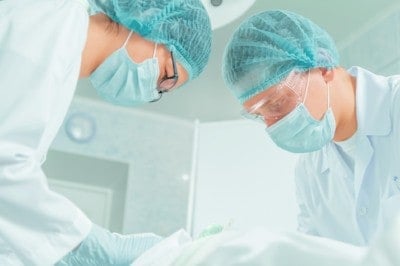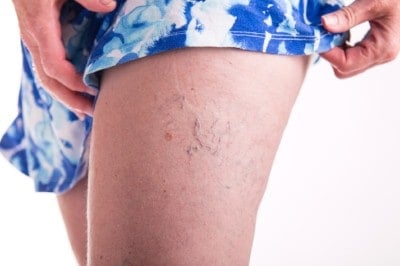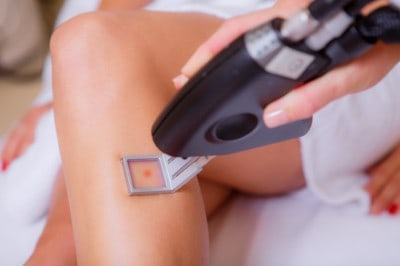
Treating Vein Disease with Vein Stripping
In years gone by the treatment for varicose veins was sometimes worse than the condition itself. This largely refers to vein stripping, a highly invasive procedure. Much gentler methods are available today. One of the main changes in how vein conditions are treated today is Duplex imaging.
Says Dr. Giraldo, “we now have Duplex ultrasound to look at the entire network of leg veins. There’s no more educated guesswork anymore. This is essential because if you’re not treating the right vein you’re not going to solve the patient’s problem.”
Vein stripping was performed by insertion of a thin, flexible rod into the vein being treated via an incision in the groin. When the rod was pushed into the vein as far as possible an access incision was made. A metal cap was screwed onto the rod, firmly trapping the vein. Finally, the rod was withdrawn, literally turning the vein inside out while pulling it from the body.
Today, more sophisticated and gentle treatments are available. “Vein stripping isn’t necessary anymore. Now we’re using thin wire catheters which heat the vein from the inside. There’s no need to pull them out,” says Dr. Giraldo. “Stripping was a bad procedure whose time has come and gone.”
As mentioned, ultra-thin catheters are used to apply brief bursts of intense heat to the vein walls. This causes the vein to collapse in on itself and eventually it’s reabsorbed completely. This usually takes about 8 weeks, and at this point, it’s as if the vein were never there. As with other procedures of this type, the deep veins take over the circulation. It’s a permanent solution to the varicose vein problem.
When to Consider Treatment for Spider or Varicose Veins
If you are bothered by the cosmetic appearance of spider veins, you might want to think about having them treated. You may be considered a good candidate for spider vein therapy by your doctor if:
You can adhere to the aftercare recommendations.
Your perspective is upbeat, and you have reasonable prospects for growth.
Conservative management techniques like weight loss, exercise, and compression stocking use haven’t been successful.
INVASIVE SURGERY ISN’T THE ONLY EFFECTIVE OPTION.
In years past, varicose vein stripping surgery was the only real option for varicose vein sufferers. This was unfortunate, since stripping was a highly invasive procedure that often left excessive scarring. It also required extended hospital stays and often required general anesthesia. Today, however, technology allows several minimally invasive treatments. These procedures are safe and are generally more effective than stripping.
Heat-based ablation (destruction) of veins has largely taken the place of vein stripping.
As a result, stripping is now rarely performed. “We use ablation all the time. It’s safer than stripping and won’t leave scars. It’s all we do,” says Dr. Giraldo. “We use a special catheter with a heating element at the tip. We inject lots of local anesthesia medication for pain control and to work as a liquid heat shield. This protects the surrounding tissue. We just heat up then remove the catheter and the vein collapses behind it.” The treated vein is then reabsorbed by the body. After a few months it’s gone completely. “The vein wasn’t working anyway, so this actually improves your circulation,” explains Dr. Giraldo. “You’ve literally got miles of veins in each leg.”

Surgical treatment for varicose veins close to the skin surface.
This procedure is known as a microphlebectomy. Says Dr.Giraldo, “we completely numb the area and remove the veins with specialized tools. It’s actually quite simple. We use very tiny access incisions. Scarring is minimal or nonexistent.”
OTHER TECHNIQUES BEING USED TODAY ARE EVEN LESS INVASIVE.
These are usually only effective on spider veins or very small varicose veins. These methods are becoming very popular since there’s almost no risk of scarring or other adverse effects.
Chief among these newer methods are sclerotherapy and laser treatments. Both have the same goal as other vein treatments. Namely, collapsing the vein so that it can be reabsorbed.

Intravenous laser therapy
Endovenous laser treatment, like radiofrequency ablation, entails inserting a catheter into your vein and utilizing an ultrasound scan to guide it into the ideal place. Your catheter is used to insert a tiny laser, which is then placed at the top of your varicose vein.
The vein is heated and sealed shut by the laser’s brief energy bursts. The ultrasound scan is used to guide the laser as it is progressively dragged along the vein, closing it along its full length. A local or general anesthetic may be used during endovenous laser therapy. Your legs may feel a little tighter after the surgery, and the bruised and painful areas may still be there. Another possibility is nerve damage, however this normally only lasts temporarily.
Sclerotherapy
If endothermal ablation therapy is not a good fit for you, you will typically be offered a procedure called sclerotherapy. During this procedure, a particular foam is injected directly into your veins. The veins become scarred by the foam, which closes them. If you’ve previously experienced deep vein thrombosis, this type of treatment might not be appropriate for you.
An ultrasound scan is used to direct the injection to the vein. In a single session, multiple veins may be treated. Typically, foam sclerotherapy is performed under local anesthesia, which numbs the area being treated with a painkiller.
Your varicose veins should start to disappear a few weeks after Sclerotherapy when stronger veins replace the damaged vein, which is no longer carrying blood.
Compression hose
To assist in getting the blood back to your heart, these stockings exert consistent pressure. Additionally, the constant pressure diminishes the swelling in your lower legs and lowers your risk of developing a blood clot. Still, you’ll be able to see the veins in your legs.
A dermatologist can check you to determine whether you need compression stockings and determine the appropriate size and level of compression.
Are There Any Side Effects Of Vein Stripping?
Vein stripping is a surgical procedure used to treat varicose veins, a condition where the veins become enlarged and twisted. Like any surgical procedure, vein stripping can have potential side effects and complications. Some possible side effects of vein stripping may include:
Pain and discomfort
Patients may experience pain and discomfort in the leg where the vein was stripped, which can last for several days or weeks after the procedure.
Swelling and bruising
Swelling and bruising around the incision site are common after vein stripping and may take several weeks to subside.
Infection
Infection at the incision site is a possible complication of any surgical procedure, including vein stripping.
Numbness or tingling
Patients may experience numbness or tingling in the affected leg or foot after the procedure, although this is usually temporary.
Blood clots
Although rare, blood clots can occur after vein stripping and can be potentially life-threatening.
How do I prevent new varicose veins from forming after vein stripping?
Preventing new varicose veins from forming after vein stripping involves adopting healthy lifestyle habits and following your healthcare provider’s recommendations. Here are some tips:
1. Maintain a Healthy Weight: Excess weight can strain your veins, so aim for a healthy weight through a balanced diet and regular exercise.
2. Exercise Regularly: Physical activity helps improve circulation and strengthens the muscles that support your veins. Aim for activities that work your legs, such as walking, cycling, or swimming.
3. Avoid Prolonged Sitting or Standing: Take breaks to move around if you have a job that requires long periods of sitting or standing.
4. Elevate Your Legs: Elevate your legs when resting or sleeping to reduce pressure on your veins.
5. Wear Compression Stockings: Your healthcare provider may recommend wearing compression stockings to help prevent new varicose veins from forming.
Are there any restrictions on physical activity after vein stripping?
After vein stripping, it’s important to follow your healthcare provider’s recommendations regarding physical activity. While you may need to limit certain activities initially, most people can gradually resume normal activities as they heal. Here are some general guidelines:
1. Walking: Walking is typically encouraged soon after vein stripping to promote circulation and prevent blood clots. Start with short walks and gradually increase the distance as you feel more comfortable.
2. Strenuous Exercise: Avoid strenuous activities, such as running, jogging, weightlifting, or high-impact aerobics, for several weeks after vein stripping. These activities can strain your veins and interfere with healing.
3. Swimming: Swimming is generally safe after vein stripping, but avoid strenuous swimming or swimming in cold water, as this can affect circulation.
4. Lifting Heavy Objects: Avoid lifting heavy objects for several weeks after vein stripping, as this can strain your veins and interfere with healing.
Can Vein Stripping Have Long-term Side Effects?
Yes, though considered a really safe treatment, it’s possible for some patients to experience some long-term side effects, some of these can be:
• Persistent numbness or tingling in the treated area because of nerve damage during the treatment
• Scarring, although chances are less
• Chronic pain and selling
• Redness at the affected area
Always remember, the chances of this happening are quite rare especially if your treatment was done by an experienced professional. Regular follow-ups and a healthy lifestyle can also help preventing such complications, so make sure to follow them.
What Happens To The Blood Flow After Vein Removal?
Once your varicose vein us removed through vein stripping, blood will start flowing through healthier veins without any problems! While it may sound concerning, it’s nothing you need to be worried about, because the veins in your legs have network of deep and superficial veins, and most of the time the removed vein is part of superficial system, which fortunately isn’t as important for a proper circulation, so removing one or two veins won’t cause any serious complications. It’s the deep veins that handle the work of transporting the blood back to the heart, as they are better at this function. Soon, the body will adjust to this change and everything will go back to normal. Which is the reason vein stripping is considered one of the safest invasive treatment for vein problems.
How Long Vein Stripping Recovery Takes?
The recovery can vary from patient to patient, but on average it can take about 2 to 4 weeks most of the time. For the first week you will have to deal with some swelling, and discomfort which can be managed with pain relievers and compression stockings provided by your doctor. Heavy work and exercises should be avoided for at least 2 weeks as well, but after that you are just about to recover completely!
Can vein stripping be performed on all types of varicose veins?
Vein stripping is generally suitable for larger varicose veins that are straight and easily accessible. However, it may not be appropriate for all types of varicose veins, particularly those that are small or twisted. Less invasive treatments, such as endovenous procedures or sclerotherapy, may be recommended for certain types of varicose veins.
SKIN RESURFACING LASERS ARE EFFECTIVE ON SPIDER VEINS
Laser treatment for spider veins is non-invasive. As a result it’s become extremely common. Laser therapy uses rapid pulses of light to achieve the same ends as sclerotherapy. Although intense heat is being produced, this is primarily limited to the vein walls so there’s very little damage to surrounding tissue. At most the only adverse effects are temporary skin redness and possible blisters. Says Dr. Giraldo, “My staff and I use skin lasers and sclero probably about 12 times every day. Patients love it!”
